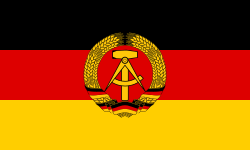
Back تاريخ ألمانيا الشرقية Arabic DDR's historie Danish Geschichte der Deutschen Demokratischen Republik German Historia de Alemania Oriental Spanish Histoire de la République démocratique allemande French היסטוריה של גרמניה המזרחית HE Storia della Repubblica Democratica Tedesca Italian Geschiedenis van de DDR Dutch Den tyske demokratiske republikks historie NB Istorgia da la Republica democratica tudestga Rhaeto-Romance
This article needs additional citations for verification. (August 2008) |

The German Democratic Republic (GDR), German: Deutsche Demokratische Republik (DDR), often known in English as East Germany, existed from 1949 to 1990.[1] It covered the area of the present-day German states of Mecklenburg-Vorpommern, Brandenburg, Berlin (excluding West Berlin), Sachsen, Sachsen-Anhalt, and Thüringen. This area was occupied by the Soviet Union at the end of World War II excluding the former eastern lands annexed by Poland and the Soviet Union, with the remaining German territory to the west occupied by the British, American, and French armies. Following the economic and political unification of the three western occupation zones under a single administration and the establishment of the Federal Republic of Germany (FRG, known colloquially as West Germany) in May 1949, the German Democratic Republic (GDR or East Germany) was founded on 7 October 1949 as a sovereign nation.
East Germany's political and economic system reflected its status as a part of the Eastern Bloc of Soviet-allied Communist countries, with the nation ruled by the Socialist Unity Party of Germany (SED) and operating with a command economy for 41 years until 3 October 1990 when East and West Germany were unified with the former being absorbed into the latter's existing system of liberal democracy and a market economy.
- ^ "The Birth of the German Democratic Republic". German Culture. 16 December 2015. Retrieved 2020-01-14.